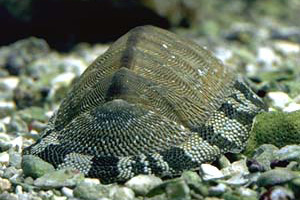
Chiton or coat-of-mail shell.
Source: Invertébrés Herbivores.
Polyplacophora Gray 1821
(Loricata Schumacher
1817, Polyplaxiphora Ducrotay-Blainville
1819, Placophora Ihering 1876)
 Chiton or coat-of-mail shell. Source: Invertébrés Herbivores. |
|
Chitons may be found mainly in the littoral surf zone. About 750 species of this primordial mollusc class are known today. The largest one is Cryptochiton stelleri with 33 cm (about 14 in.), living on the American north western coast.
In colloquial language, chitons are also called coat-of-mail shells, their shell resembling the segmental armour on a knight's gauntlet, though, as we shall see later, the shell of a chiton is not segmented in the biological sense of the word.
Not only chitons' shells are hard. Chitons, like snails, possess a rasp tongue (radula), which they use to rasp food off the ground, if they are not among the few carnivorous species, such as Placiphorella rubra (see below).
The Eastern beaded chiton (Chaetopleura apiculata) living in the Gulf of Mexico, the North-Western Atlantic, the East Pacific as well as off Colombia, has the hardest teeth known in nature - Chaetopleura often intensively rasps off stones where food can be found in cracks and crevices. Materials research institutes now examine, how this hard material (it interestingly is not brittle like many hard materials) develops by interchanges between organic and inorganic materials and how it possibly could be reproduced.
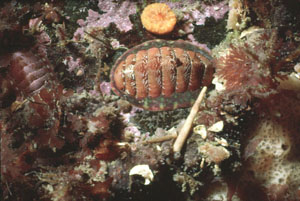 Two chitons (Tonicella insignis and lineata, left) in their natural living area in Puget Sound (Washington state). Source: Ron Shimek. |
| Gordon, L. M.; Joester D. (2011): "Nanoscale chemical tomography of buried organic–inorganic interfaces in the chiton tooth". Nature 469: 194-197. |
Contrary to more highly developed mollusc groups, chitons do not possess a calcareous shell. Instead, their back is protected by the sturdy cuticula of the mantle. Compared to the molluscs' ancestors, the chitons' cuticula extends only to the perimeter of its' back side. That is why it is also called perinotum or girdle. The back itself is protected by eight overlapping calcareous shell plates, which give the chiton its gauntlet-like appearance. In some chiton species the perinotum extends further up the back, which is why Cryptochiton stelleri, already mentioned earlier, also is called gumboot chiton.
Chiton in principle is only one of many possible systematic names in the group, that is scientifically called Polyplacophora (Molluscs bearing multiple shell plates).
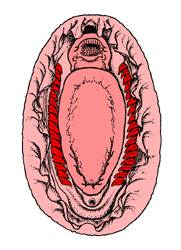
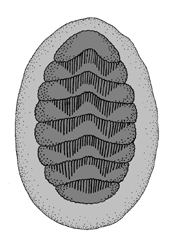 Ventral and dorsal side of a chiton (Polyplacophora). Light grey: girdle; dark grey: shell plates; light pink: mantle; dark pink: foot; red: gills. Source: Livingstone, Biodidac, further editing: R. Nordsieck. |
A chiton's body is very well adapted to life in the surf. Looking at a chiton's ventral side is not easy, as it is always showing to the underground and a chiton may cling to a rock almost as hard as a limpet.
It does so with its powerful foot. At the frontal end of the animal the mouth opening is visible. Like among other molluscs, the chiton's sturdy backside is referred to as mantle (pallium). Contrary to snails, for example, chitons, have no mantle cavity containing gills. Instead, there is a groove running almost all around the animal between mantle and foot containing numerous mollusc-type gills or ctenidia.
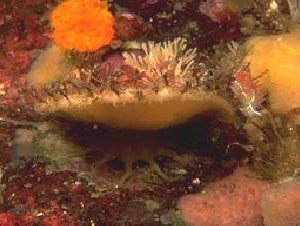 Frontal view of Placiphorella rufa, a carnivorous chiton. Source: "Veiled Chiton" by Kerry L. Werry. |
As was already mentioned, chitons, as well as other molluscs, possess a radula, which enables them to grind down their food. Below it, there is a so-called subradular organ – a chemical sense organ which gives the chiton information about suitable food in the vicinity. By far the most chitons are herbivores and live on algae they rasp from the rocks and also from mussels in their vicinity. When doing so, they cling hard to the ground with their powerful foot, supported by the sturdy girdle.
Molluscs usually do not have longitudinal muscles, which would be rendered useless by the hard dorsal shell. Chitons, however, do have a strong longitudinal muscle, that enables them to roll in like a woodlouse. Should the chiton be separated from the ground it can so protect all of its body, just as a hedgehog would.
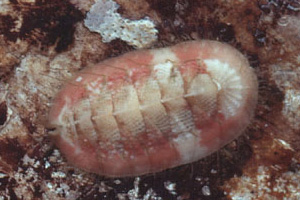 A chiton (Mopalia porifera). Source: Ron Shimek. |
Chitons' light sense organs are a special adaptation to their way of life.
In the dorsal shell plates of a chiton there are the so-called aesthetes. Those are mechanical sense organs, which can detect water movements. Usually they are also branched to several micro-aesthetes.
Inside the aesthetes, cuticular eyes can be developed. There are two types of cuticular eyes in chitons: The intrapigmentary cuticular eyes are situated inside the aesthetes, built from a small pigment cup with a lens above it. The extrapigmentary cuticular eyes instead are situated in the outer skin (tegument) outside of the aesthetes. The terminal cap of the aesthete has developed to form the lens.
Their cuticular eyes enable chitons to tell apart light and shadow on their dorsal side without having to remove the protective girdle from the ground. In species of Acanthopleura, several thousand cuticular eyes can be dispersed over the chiton's dorsal side.
The majority of chitons have separate sexes. The pair of sexual organs (gonads) usually are grown together forming one organ with two channels leading into the mantle groove. Fertilisation takes place outside in the surrounding water. Chiton development passes a larval state resembling a trochophora larva, which by a metamorphosis changes into a young chiton much more like the adult.
Some few chiton species (Placiphorella) have changed to a carnivorous way of living. They lift the frontal part of the girdle from the ground an watch for prey, usually small crustaceans. Small tentacles around the mouth detect the prey, which is then caught by firmly pressing the girdle to the ground.